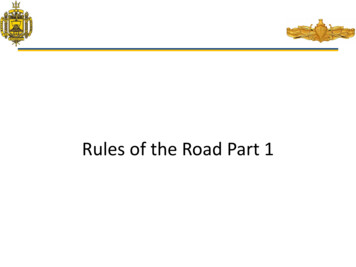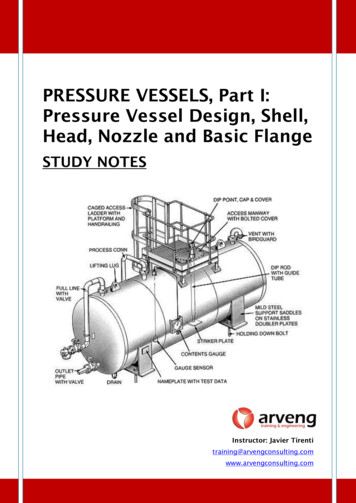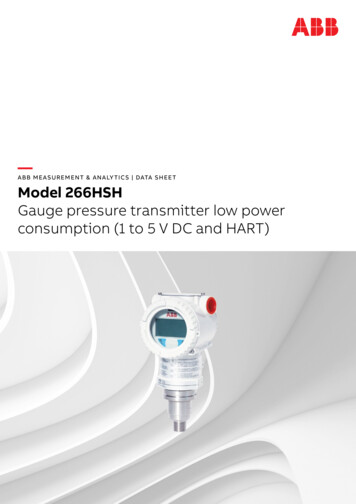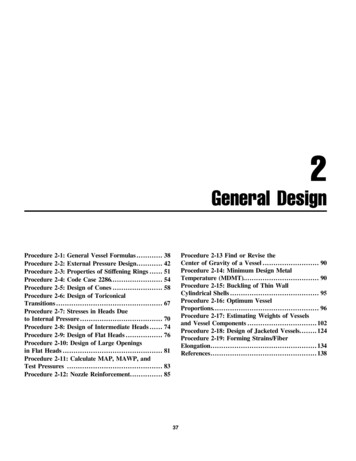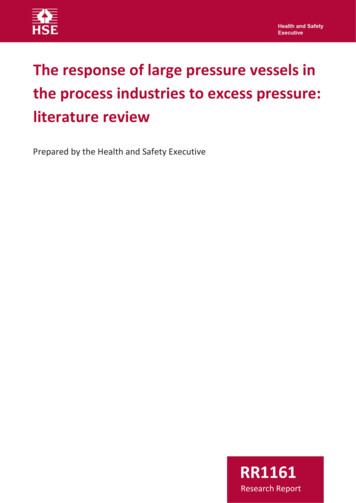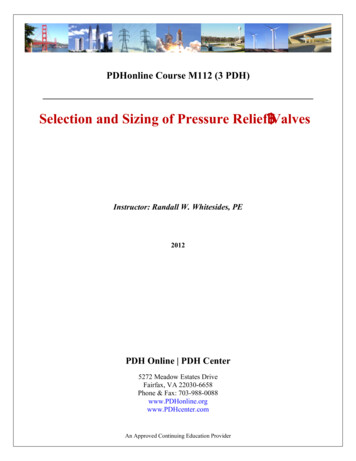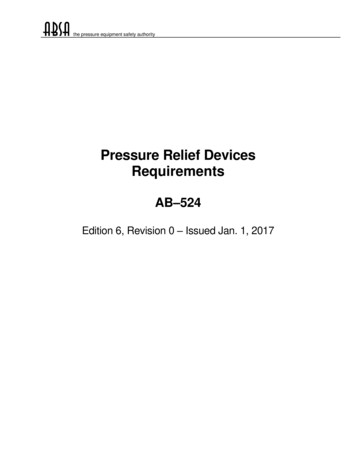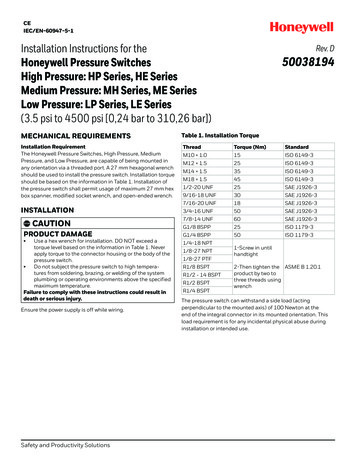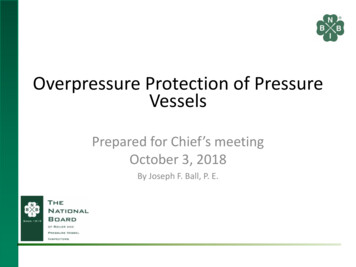
Transcription
Overpressure Protection of PressureVesselsPrepared for Chief’s meetingOctober 3, 2018By Joseph F. Ball, P. E.
Overview of Session Compare/contrast Section I and IV provisions forOverpresssure Protection with Section VIII Overview of Section VIII pressure reliefrequirements Process for review of Section VIII pressure vesseloverpressure protection installationsSection VIII OPP
How do Jurisdictions becomeInvolved?- Formally through requirements for operatingpermits, installation inspection or periodicinspection (NBIC refers to Original Code ofConstruction)- Informally: may be asked to comment oninstallations, or assist other agencies whenissues arise- “Accidentally” when there is a pressureequipment incidentSection VIII OPP
Jurisdictional CoverageTabulation of ASME Boiler and Pressure Vessels Codes(from NB web page)Requires Section VIIIStates: 41Provinces: 12Cities: 15Do not require Section VIIIStates: 9, Provinces: 1, Cities: 1(slightly different numbers when using Stamping Requirementsby Jurisdiction)Section VIII OPP
Jurisdictional CoverageSection VIII OPP
ExampleState of Ohio All boilers and pressure vessels proposed for use in the state of Ohio shall bedesigned, constructed, installed, altered, repaired, maintained, and operatedin accordance with the rules adopted by the board as prescribed in Chapters4101:4-1 to 4101:4-10 of the Administrative Code, except as follows: (A) Unless exempt by paragraph (B) of rule 4101:4-2-01 of the AdministrativeCode, upon completion of an installation and in accordance with rules1301:3-5-01 to 1301:3-5-09 of the Administrative Code, all boilers shall beinspected by a general or special inspector who holds an Ohio commissionissued by the superintendent. (A) All existing boilers and pressure vessels and the associated equipment,controls, devices, and safeguards shall be maintained in a safe and sanitarycondition, in good working order, and free of leaks and defects. The owneror the owner's designated agent shall be responsible for the maintenance ofsuch boilers and pressure vessels and associated equipment, controls,devices, and safeguards.Section VIII OPP
Sections I and IVSection I: Overpressure protection is provided bythe boiler manufacturer.Documented on boiler data report: (for example P2form) and P7 form when necessary.Section IV: Overpressure protection requirementsare defined by boiler manufacturer who appliessafety or safety relief valve capacity (minimum) tonameplate (HG-530.1) or Maximum allowable inputin Btu/hr (HLW-602.1)Section VIII OPP
Section VIIIUG-125(a) all pressure vessels irrespective of size orpressure, shall be provided with overpressureprotection in accordance with the requirements ofUG-125 through UG-138 (pressure relief devices) orwith overpressure protection by system design inaccordance with UG-140, or a combination of thetwo.Section VIII OPP
Section VIIIUG-125(a)(1)(1) It is the user’s or his/her designated agent’sresponsibility to identify all potential overpressurescenarios and the method of overpressureprotection used to mitigate each scenario.(2) It is the responsibility of the user to ensure thatthe required overpressure protection system isproperly installed prior to initial operation.Section VIII OPP
Section VIIIUG-125 (a)(4) The overpressure protection systemneed not be supplied by the vessel Manufacturer.Section VIII OPP
What is a User?Section VIII, Appendix NN“Guidance to the Responsibilities of the User andDesignated Agent”(1) “ a “user” as defined in this Division is anentity that defines the design conditions andparameters of the pressure vessel underconsideration and communicates these conditionsand parameters to the Manufacturer.”Section VIII OPP
What is a User?The user could have a designated agent:(a) The designated agent may be:(1) a design agency specifically engaged by the user(2) the Manufacturer of a system for a specific servicethat includes a pressure vessel as a part that ispurchased by the user, or(3) an organization that offers pressure vessels forsale or lease for specific servicesSection VIII OPP
Section VIII overviewUG-125(a)(3)If a pressure relief device(s) is to be installed, it isthe responsibility of the user or his/her designatedagent to size and select the pressure relief device(s)based on its intended service. Intended serviceconsiderations shall include, but not necessarily belimited to, the following:(-a) normal operating and upset conditions(-b) fluids(-c) fluid phasesSection VIII OPP
Section VIII overviewUG-125(b) Unfired steam boilers equipped withpressure relief devices as required by Section I Section VIII OPP
Capacity related requirementsUG-125(c) lists overpressure limits.Single device: Shall prevent the pressure from risingmore than 10% or 3 psi above MAWP whichever isgreaterMultiple devices: Pressure can not rise more than16% or 4 psi above MAWP, whichever is greater(Need system capacity to evaluate theserequirements)Section VIII OPP
Capacity related requirementsUG-125(c)(2) When a vessel can be exposed to fireor other unexpected source of external heat,pressure cannot rise more than 21% above MAWPCan be same the overpressure protection device asprevious or a supplemental device.(Again, system capacity is needed)Section VIII OPP
Capacity related requirementsUG-125(c)(3)- Non-refrigerated liquefied compressed gases atambient temperate, with no permanent supplyconnection- Intended primarily for protection against fire orunexpected external heat- Vessel has sufficient ullage to protect against beingliquid filledValves for this service are rated at 20% overpressure(need system capacity) and have a positive setpressure toleranceSection VIII OPP
Section VIII OPP
Capacity related requirementsUG-133(d)(d) Heat exchangers and similar vessels shall beprotected with a pressure relief device of sufficientcapacity to avoid overpressure in case of an internalfailure. (How much is sufficient?)Section VIII OPP
Other capacity relatedrequirementsUG-135 (b)(1)The opening through all pipe, fittings, andnonreclosing pressure relief devices (if installed)between a pressure vessel and its pressure reliefvalve shall have at least the area of the pressurerelief valve inlet. The characteristics of thisupstream system shall be such that the pressuredrop will not reduce the relieving capacity belowthat required or adversely affect the properoperation of the pressure relief valve.Section VIII OPP
Other capacity relatedrequirementsUG-135(f)The size of the discharge lines shall be such that anypressure that may exist or develop will not reducethe relieving capacity of the pressure relief devicesbelow that required to properly protect the vessel,or adversely affect the proper operation of thepressure relief devices.Section VIII OPP
Jurisdictional ActionsField Inspector LevelBasic evaluation of installed pressure reliefdevices including:1) Relationship of device set pressure toMAWP2) Correct type of device for the application:Steam, gas, liquid etc.3) Certification status of deviceSection VIII OPP
Jurisdictional Actions (in the field)4) Installation condition (includes pipe sizes andlength, drainage, safe discharge, combined areas,device condition etc.)Also UG-125(d):Pressure relief devices shall be located and installedso they are accessible for testing, inspection,replacement and repair Section VIII OPP
Jurisdictional Actions (in the field)5) Evaluation of “relief path”From Appendix M:pressure relief path: consists of all equipment, pipe,fittings, and valves in the flow path between anyprotected equipment and its pressure-relieving device,and between the pressure-relieving device and thedischarge point of the relieving stream.May include isolation valves for pressure relief valvesSection VIII OPP
Jurisdictional Actions (in the field)6) Evaluation of changes- Has the process been changed?- Has the protected equipment been changed?- Has the pressure relief device been replaced?Section VIII OPP
Jurisdictional Actions (in the field)7) Recognition of unique circumstances Overpressure Protection by System Design(UG-140) Use of isolation valves Large changes in the process or protectedequipmentAvoid system capacity evaluations by the InspectorSection VIII OPP
Jurisdictional ActionsAccepting new or revised installations, andsupporting the field inspector “Code” responsibility remains with the User When needed, calculations should come fromthem Be able to do reviews of the design processemployed by the user Be aware of unique circumstancesSection VIII OPP
Jurisdictional ActionsProcess for Jurisdictional design review:1. Understand protected equipmentData reports, description of theinstallation2. Understand the system where theprotected equipment is installed (P&IDdrawings are helpful)3. Understand the basic process in the protectedequipment.4. Audit that the User has done a thoroughreview, including complete installation anddevice sizing.Section VIII OPP
Jurisdictional ActionsCode gives guidance for sizing by reference only.Appendix M-13: Sizing of Pressure Relief Devicesfor Fire Conditions lists a number of guidancedocuments including API-520 and 521UG-140 (a)(2) also references API-521Section VIII OPP
Basic API-520 requirement“To establish the size and design of a pressurerelied device for any application, the designer shallfirst determine the conditions for whichoverpressure protection may be required. Careshould be exercised on establishing the variouscontingencies that could result in overpressure.”(par. 5.1.1)Section VIII OPP
Basic API-520 requirement“The contingencies that can cause overpressureshall be evaluated in terms of the pressuresgenerated and the rate at which fluids are requiredto be relieved.” (par. 5.1.2)Section VIII OPP
Potential for OverpressureClosed outlets on vessels (API-521, par. 4.3.2)Section VIII OPP
Potential for OverpressureInadvertent valve opening (API-521, par. 4.3.3)Consider bypass valve in open positionSection VIII OPP
Potential for OverpressureCheck valve leakage or failure (API-521, par. 4.3.4)One step to limit capacity: Install 2 devices in seriesSection VIII OPP
Potential for OverpressureUtility failure, both complete and partial (API-521, par. 4.3.5)Examples Electricity: pumps, fans compressors, instrumentation, motoroperated valves Cooling fluid (water or other): Condensers coolers, jackets onrotating equipment Instrument air: Transmitters, controllers, control valves, alarmand shutdown systems Process steam: Turbines for pumps, compressors, blowers,combustion fans Steam or other heating fluid: heat exchangers Fuel: boilers, reheaters, compressors, gas turbines Inert gas: seals, catalytic reactors, purges for instrumentationSection VIII OPP
Potential for OverpressureProcess changes/ chemical reactions (API-521, par.4.3.15) Failure of Controls Failure of outlet control devices (no credit for“fail- stationary” valves) Runaway chemical reactions: DIERSmethodology may be used Bench tests used to simulate upset conditionsTwo phase flow needs to be accounted forSection VIII OPP
Potential for OverpressureHydraulic Expansion (API-521, par. 5.14)Overpressure caused by increase in liquidvolume caused by an increase in temperature(“thermal relief”) – a ¾ x 1 valve is often usedShould also be considered for gas storage vessels.Section VIII OPP
Potential for OverpressureHeat-Transfer Equipment Failure (API-521, par. 5.19)Internal failure of high to low pressure side in a heatexchanger. Usually modeled as complete break of asingle tube (flow area is the internal area of twotubes)Section VIII OPP
Potential for OverpressureFire case (API-521, par. 5.15) Used for “external pool fires”Primarily for liquid /gas systemsVessel wetted area used (limited to 25 ft. above groundor less)Credit may be taken for insulationVery high temperatures may cause vessel rupture, andadditional protective methods may be required-Water cooling of vessel-Depressurizing systems-Vessel sitingSection VIII OPP
Arrangement of SystemsUG-125 (g)(g) The pressure relief devices required in (a) aboveneed not be installed directly on a pressure vessel wheneither of the following conditions apply:(1) the source of pressure is external to the vesseland is under such positive control that the pressure inthe vessel cannot exceed the maximum allowable workingpressure at the operating temperature except as permittedin (c) above (see UG-98), or under the conditionsset forth in Nonmandatory Appendix M.Section VIII OPP
Arrangement of SystemsAppendix M-1(a) The rules in this Appendix are for general informationonly, because they pertain to the installation and operationof pressure vessels, which are the prerogative andresponsibility of the law enforcement authorities in thosestates and municipalities which have made provision forthe enforcement of Section VIII.(b) It is permissible to use any departures suggestedherein from provisions in the mandatory parts of thisDivision when granted by the authority having legaljurisdiction over the installation of pressure vessels.Section VIII OPP
Arrangement of SystemsM-5.5 STOP VALVES PROVIDED IN SYSTEMS FOR WHICH THEPRESSURE ORIGINATES EXCLUSIVELY FROM AN OUTSIDE SOURCEA vessel or system [see UG-133(c)] for which the pressureoriginates from an outside source exclusively may have individualpressure-relieving devices on each vessel, or connected to anypoint on the connecting piping, or on any one of the vessels to beprotected. Under such an arrangement, there may be stop valve(s)between any vessel and the pressure-relieving devices, and thesestop valve(s) need not have any administrative controls, valveoperation controls, or valve failure controls, provided that the stopvalves also isolate the vessel from the source of pressure.Section VIII OPP
Arrangement of SystemsHave remaining causes of overpressure beenconsidered?Section VIII OPP
Special ConditionsUG-140 OVERPRESSURE PROTECTION BY SYSTEM DESIGN(a) A pressure vessel does not require a pressure reliefdevice if the pressure is self‐limiting (e.g., the maximumdischarge pressure of a pump or compressor), and thispressure is less than or equal to the MAWP of the vesselat the coincident temperature and the following conditionsare met:(1) The decision to limit the pressure by system designis the responsibility of the user.Section VIII OPP
Special ConditionsUG-140 cont.(2) The user shall conduct a detailed analysis toidentify and examine all potential overpressurescenarios. (Pressure cannot exceed MAWP)(3) The results of the analysis shall be documentedand signed by the individual in responsible chargeof the management of the operation of the vessel.Section VIII OPP
Special ConditionsUG-140 cont.(b) If the pressure is not self‐limiting, a pressure vesselmay be protected from overpressure by system designor by a combination of overpressure by system designand pressure relief devices, if the following conditionsare met.Requires detailed design review and signed report.Code acknowledges: “If no pressure relief device is tobe installed, acceptance of the jurisdiction may berequired.”Section VIII OPP
Special ConditionsInternal Explosion (Deflagration)Rupture disks or explosion panels should beused instead of pressure relief valvesControl explosive mixtures (purge with inertgas, suitable startup or shutdown procedures)Active systems for explosion prevention(Ref.: NFPA 68, Guide for Venting ofDeflagrations, NFPA 69, Deflagration PressureContainment)Section VIII OPP
Excluded ConditionsTransient Pressure Surges (API-521, par. 4.3.13)Water and steam hammer: Often caused byquick closing valves: limit valve closing speed, installpulsation dampenersCondensate-induced hammer: Isolation ofsteam bubble by cold condensate with rapidcollapse of steam bubble: eliminate coldcondensate by traps, steam pipe slope, control ofstartup processesSection VIII OPP
Excluded ConditionsJet Fires (API-521, par. 5.16)Jet fire causes intense, localized overheating of themetal wall where the fire impinges. Failure canoccur without increasing the pressure in the vessel.Consider programs for prevention of leaks,fireproofing, depressurizing systems, and isolationof the leak. Equipment and flange orientation andemergency response are also considered.Section VIII OPP
Specification of OverpressureProtectionAll sizing scenarios are considered, and pressure reliefdevices to cover the most severe case is supplied.“The simultaneous occurrence of two or moreunrelated causes of overpressure (known as double ormultiple jeopardy) is not a basis for design.” (API-521,par. 4.2.1)Note: Not all multiple failures are double jeopardy.Example: Leaking check valve during pump failureSection VIII OPP
ConclusionComprehensive design of a complete overpressureprotection system should be a detailed exhaustiveprocess.Jurisdictions need to rely on the work done by the user,but should have enough knowledge about the processto know what to look at.Assistance can be obtained from other agencies andmultiple standards. The National Board will be willingto assist where necessary.Section VIII OPP
Section VIII OPP
Tabulation of ASME Boiler and Pressure Vessels Codes (from NB web page) Requires Section VIII States: 41 Provinces: 12 . condition, in good working order, and free of leaks and defects. The owner . between a pressure vessel and its pressure relief valve shall have at least the area of the pressure
